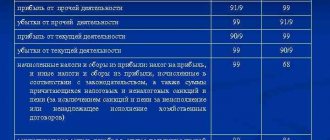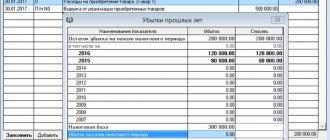Accounting account 84 is used to reflect and analyze generalized information about retained earnings (uncovered loss), the amount of which is determined based on the results of the reporting financial year. Using standard postings and illustrative examples, we will help you understand the specifics of using account 84 and the features of recording transactions with retained earnings.
Characteristics of account 84
Account 84 “Retained earnings” is one of the most important financial accounts of any organization. It is to this account that the final entries from the account are written off. 99, depending on the result obtained for the reporting year - profit (income exceeds costs) or loss (costs exceed income). In addition, from the account 84 money is used to pay income to the founders - both employees of the enterprise and third parties.
84 accounting account allows you to obtain aggregate information about the amount of profit/loss after tax for all types of company activities that have not yet been distributed for various purposes. Analytical accounting is organized in order to monitor the performance of individual commercial areas. At the same time, you can divide the unused profit and the profit already spent on the development of the enterprise, and also see what part of the financial result was formed from the current year’s activities and what part relates to previous periods.
Correspondent accounts of account 84
The main corresponding account, which determines the financial significance of account 84 at the end of the year, is account 99 “Profits and losses”. Its debit balance, demonstrating the unprofitability of the activity, is written off to zero at Kt84 , and the credit balance, indicating the profitability of the enterprise, at Dt84 .
Posting to account 84 is carried out once a year, after completion of other account transactions.
The remaining correspondent accounts depend on the purposes of profit distribution or the methods of covering losses provided for in the company documents:
- account 70 - when paying dividends to employees of the enterprise;
- account 75 – when paying dividends or collecting additional funds from the founders of the company;
- account 80 – when cash flows through the authorized capital;
- account 82 - when compensating for losses or directing profits to the reserve fund;
- account 83 – for correspondence with additional capital funds.
Count 84 – active or passive?
Account 84 “Retained Earnings” is a striking example of active-passive accounts, it is included in Section VII of the Chart of Accounts by order of the Ministry of Finance No. 94n dated October 31, 2000, and is often a significant specific part of the entire capital of the organization. The cumulative method of reflecting data on account 84 (the entries are given below) serves to generate information for the period of operation of the enterprise - from the date of registration to the liquidation of the business.
To the question, is credit 84 of the account a profit or a loss, the answer option will, of course, be the first one - profit, since replenishment or increase of the account, that is, the write-off of profit is carried out on the credit of the account. 84 in correspondence with accounts 99, , , , , 84, , 82. In this case, the debit of account 84 shows a decrease in financial. result, that is, writing off the loss in correspondence with accounts - 99, 70, 75, 80, 83, 82, as well as , , 52.
Thus, the credit balance on account 84 means the net profit of the enterprise, which can be spent on various purposes - from paying income to the founders to investing in business development. And the debit balance on account 84 means an uncovered loss in activity.
84 account in accounting - subaccounts:
- 84.1 – for profits that are subject to distribution.
- 84.2 – for loss subject to coverage.
- 84.3 – for profit in circulation.
- 84.4 – for profits already used.
Typical entries for account 84 “Retained earnings (uncovered loss)”
The correspondence of accounts and the main entries for account 84 “Retained earnings (uncovered loss)” are presented in the table:
| Dt | CT | Wiring Description |
| 99 | 84.01 | Reflection of the amount of net profit based on the final turnover for the reporting year (December) |
| 84.01 | 75.02/70 | Reflection of dividend payments (as of the date of decision making) |
| 84.01 | 82/80 | Net profit attributed to reserve capital/authorized capital |
| 80 | 84 | Reflection of the reduction of the authorized capital to the amount of net assets (as of the date of state registration) |
| 84.02 | 99 | Reflection of the amount of loss based on the final turnover for the reporting year (December) |
| 99 | 84.03 | Reflection of the total amount of retained earnings between shareholders |
| 82/75/80 | 84.02 | Reflection of covering the loss at the expense of reserve capital (as of the date of the decision)/own funds of the founders/authorized capital (after state registration of these changes) |
| 84.03 | 84.02 | Covering the loss with the accumulated amount of retained earnings |
| 84.03 | 84.04 | Reflection of the fact of use of retained earnings when creating property |
Closing account 84 at the end of the year - postings
Monthly postings to the account. 84 are performed to write off the results of the enterprise’s activities. The accountant closes profit/loss like this:
- D 90.9 K 99 or D 99 K 90.9 – profit (or loss) from the main activity is reflected.
- D 99 K 84 – the state of emergency is written off (net profit). Accordingly, the credit 84 of the account shows a profit, and the debit (entry D 84 K 99) shows a loss.
At the end of the year, the balance sheet is reformed, meaning the corresponding accounts are consistently reset to zero. How is account 84 formed when disposing of funds ? Postings are made depending on the purpose of the write-off:
- D 84 K 75 – money was allocated to accrue annual dividends.
- D 84 K 80 – to increase the authorized capital.
- D 84 K 82 – for the formation of reserve capital.
- D 84.3 K 84.2 – part of the accumulated loss is covered.
Conclusion - we found out that the answer to the question, Kt 84 account - is profit or loss, in any case, means the company’s net profit, which remains after taxation and can be used for the necessary purposes according to Law No. 208-FZ of December 26, 1995. and 14-FZ dated 02/08/98
Results
Retained earnings are after-tax earnings that are not used for dividends paid to the founders of the company. The balance sheet reflects the IR for the entire period of the company’s activities.
IR represents a share of a company's equity capital.
It can be directed by order of the owners for the purposes provided for by laws No. 14-FZ and No. 208-FZ. You can find more complete information on the topic in ConsultantPlus. Free trial access to the system for 2 days.
Using profits to purchase property
According to the accounting policy of Megapolis JSC, one of the sources of capital investment is retained earnings. In January 2020, Megapolis JSC purchased a conveyor machine worth RUB 175,300, VAT RUB 741.
The following entries were made in the accounting of Megapolis JSC:
| Dt | CT | Description | Sum | Document |
| 08 | 60 | Purchased a conveyor machine (RUB 175,300 - RUB 741) | RUR 148,559 | Packing list |
| 19.1 | 60 | The amount of input VAT on the purchased machine is taken into account | .741 rub. | Invoice |
| 01 | 08 | The purchased conveyor machine was accepted for accounting | RUR 148,559 | OS commissioning certificate |
| 68 VAT | 19.1 | The amount of input VAT accepted for deduction | .741 rub. | Invoice |
| 84.02 | 84.03 | Targeted financing of the cost of the purchased machine has been taken into account (through the use of net profit) | RUR 148,559 | Consignment note, Asset entry certificate, Profit and loss report |
What can retained earnings be spent on?
First of all, it must be said that profits can be distributed only once and only based on the decision of the meeting. If there is no solution, then profits cannot be distributed.
It is important that distribution occurs only once a year - at the meeting of participants at the end of the year. If a decision is made not to distribute profit, then it will be reflected on the credit of account 84; in subsequent years it will be considered undistributed profit from previous years and can only be used for reinvestment.
When determining what the net profit for the year can be “spent” on, it is also necessary to take into account the provisions of the organization’s accounting policies.
Net profit can be used for: (click to expand)
- Creation of reserve capital (for joint-stock companies, the creation of this capital is mandatory);
- Repayment of losses from previous years;
- Payment of dividends to company participants in accordance with the size of their share (contributions);
- Other purposes (vacations for employees, financial assistance, charity, etc.).
Profit distributed among shareholders
At the end of 2015, JSC Fantasia received a profit of 184,200 rubles. By decision of the board of JSC Fantasia it was established that profits will be distributed as follows:
- replenishment of the reserve fund - 12% of profits;
- payment of dividends - 65% of profits.
The accountant of Fantasia JSC made the following entries:
| Dt | CT | Description | Sum | Document |
| 99 | 84.01 Retained earnings | The amount of net profit received by JSC Fantasia is reflected | 184,200 rub. | Profit and Loss Statement |
| 84.01 Retained earnings | 82 | Part of the funds from the amount of retained earnings was used to replenish the reserve fund (RUB 184,200 * 12%) | RUR 22,104 | Minutes of the board's decision |
| 84.01 Retained earnings | 75 | Part of the funds from the amount of retained earnings was used to pay dividends to the shareholders of JSC Fantasia (RUB 184,200 * 65%) | 119.730 rub. | Minutes of the board's decision |
| 84.01 Retained earnings | 84.02 Profits subject to distribution | The balance of funds in the form of retained earnings is reflected in the accounts (184,200 rubles - 22,104 rubles - 119,730 rubles) | RUB 42,366 | Minutes of the board's decision |
Repayment of uncovered losses...
Since account 84 is active-passive, repayment of an uncovered loss can be considered as a special case of the formation of retained earnings.
Operations are also carried out on the credit of account 84, but they do not increase the credit balance (retained earnings), but reduce the debit balance (uncovered loss). …at the expense of reserve capital
Based on clause 69 of the Regulations on accounting and financial reporting in the Russian Federation, reserve capital is used to cover losses. Covering the loss at the expense of reserve capital is carried out by debiting account 82 “Reserve capital” and crediting account 84 “Retained earnings (uncovered loss)”.
Example 4
According to data for 2013, the uncovered loss of the joint-stock company amounted to 1,890,378 rubles. Reserve capital is 634,120 rubles. On March 12, 2014, the Board of Directors decided to partially cover the loss using reserve capital funds.








